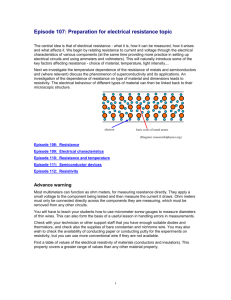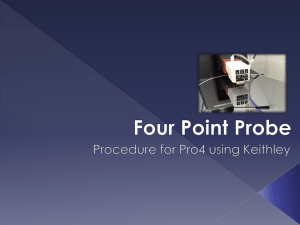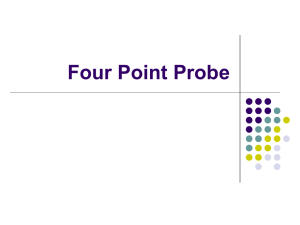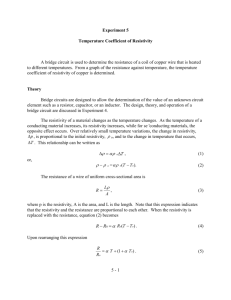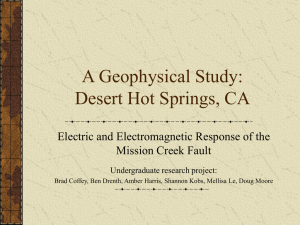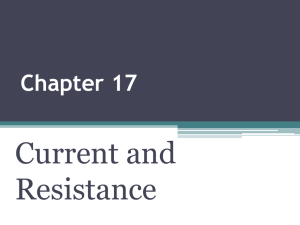View/Open - Hasanuddin University
advertisement
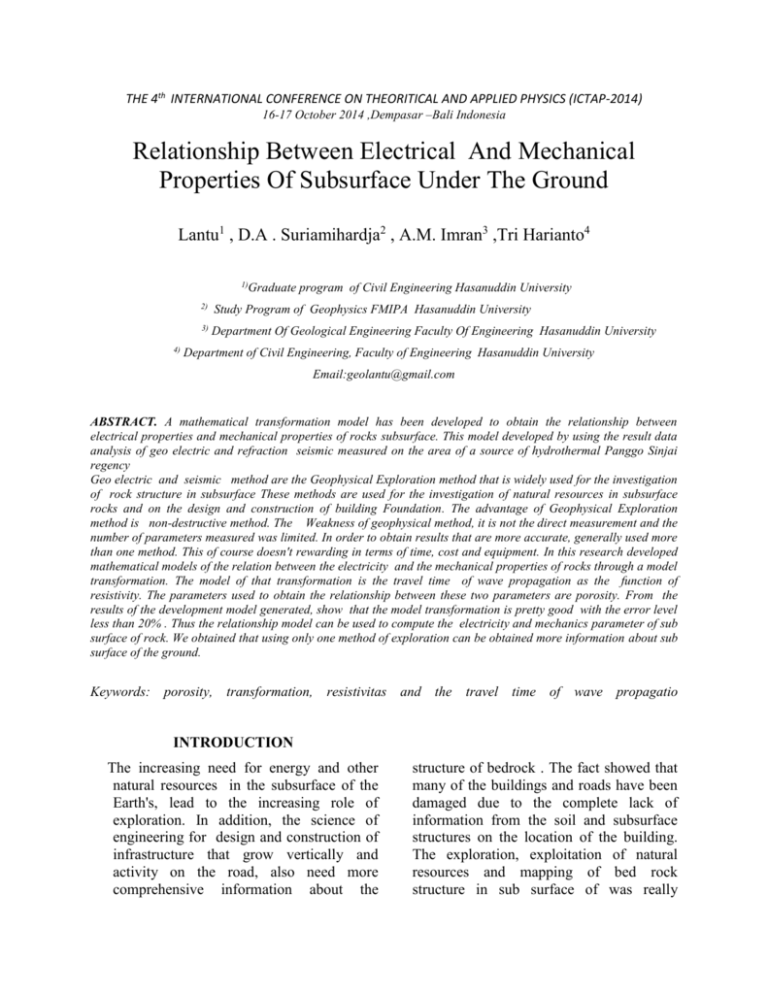
THE 4th INTERNATIONAL CONFERENCE ON THEORITICAL AND APPLIED PHYSICS (ICTAP-2014)
16-17 October 2014 ,Dempasar –Bali Indonesia
Relationship Between Electrical And Mechanical
Properties Of Subsurface Under The Ground
Lantu1 , D.A . Suriamihardja2 , A.M. Imran3 ,Tri Harianto4
1)
4)
Graduate program of Civil Engineering Hasanuddin University
2)
Study Program of Geophysics FMIPA Hasanuddin University
3)
Department Of Geological Engineering Faculty Of Engineering Hasanuddin University
Department of Civil Engineering, Faculty of Engineering Hasanuddin University
Email:geolantu@gmail.com
ABSTRACT. A mathematical transformation model has been developed to obtain the relationship between
electrical properties and mechanical properties of rocks subsurface. This model developed by using the result data
analysis of geo electric and refraction seismic measured on the area of a source of hydrothermal Panggo Sinjai
regency
Geo electric and seismic method are the Geophysical Exploration method that is widely used for the investigation
of rock structure in subsurface These methods are used for the investigation of natural resources in subsurface
rocks and on the design and construction of building Foundation. The advantage of Geophysical Exploration
method is non-destructive method. The Weakness of geophysical method, it is not the direct measurement and the
number of parameters measured was limited. In order to obtain results that are more accurate, generally used more
than one method. This of course doesn't rewarding in terms of time, cost and equipment. In this research developed
mathematical models of the relation between the electricity and the mechanical properties of rocks through a model
transformation. The model of that transformation is the travel time of wave propagation as the function of
resistivity. The parameters used to obtain the relationship between these two parameters are porosity. From the
results of the development model generated, show that the model transformation is pretty good with the error level
less than 20% . Thus the relationship model can be used to compute the electricity and mechanics parameter of sub
surface of rock. We obtained that using only one method of exploration can be obtained more information about sub
surface of the ground.
Keywords:
porosity, transformation, resistivitas and the
travel time of
wave
propagatio
INTRODUCTION
The increasing need for energy and other
natural resources in the subsurface of the
Earth's, lead to the increasing role of
exploration. In addition, the science of
engineering for design and construction of
infrastructure that grow vertically and
activity on the road, also need more
comprehensive information about the
structure of bedrock . The fact showed that
many of the buildings and roads have been
damaged due to the complete lack of
information from the soil and subsurface
structures on the location of the building.
The exploration, exploitation of natural
resources and mapping of bed rock
structure in sub surface of was really
THE 4th INTERNATIONAL CONFERENCE ON THEORITICAL AND APPLIED PHYSICS (ICTAP-2014)
16-17 October 2014 ,Dempasar –Bali Indonesia
needed, but environmental sustainability
due to the exploration and exploitation
must remain guaranteed. The Geophysical
explorations are the methods that are
reasonably priced and does nondestructive
method, the very potential for the
exploration and mapping of the bedrock
structure comprehensively. However, the
excellence of geophysical exploration, this
methods also have fundamental flaws.
1. Not the direct measurement
2. With only using one method the number of
parameters obtained limited.
3. To obtain accurate results and much
parameters measured, needed more than one
method.
To use more than one exploration method on
an object with a common purpose, it is not
efficient and ineffectual in use of time, funds
and equipment. The resolve this problem, have
been developed a transformation model that
can link between electrical properties and
mechanical properties of rocks. That
transformation model is a model of the
relationship between the travel time wave
propagation
with the resistivity. The
development of technology and information
processing are also utilized as an additional
device to obtain a solution of that problem.
Realization of these issue, by developing
mathematical models that can be establishing a
relation of representative stocks between the
mechanical properties and
the nature of
electricity rocks at the sub surface of the earth
through the utilization of porosity parameters.
By using the porosity parameters, we able to
constructed a correlation between the nature
of electricity and of the mechanical properties
of rocks at the sub surface.
Geophysical methods are commonly used to
determine the porosity of sub surface of the
rocks are the seismic method and geo
electrical method. The geo electrical is used
to find out the nature of the electrical
conductivity of rocks and the seismic
method is use to determine the ability of
wave propagation in sub surface of rock.
The velocity of the wave propagation
parameters are used to calculate the
elasticity properties of rock. The porosity
will be the same, if the exploration with
seismic method and geo electrical method
is performed on the same conditions. By
using this assumption, have developed a
mathematical model that can connect
between the electrical properties and
mechanical properties of rocks.
MATERIALS AND METHODS
Data were collected at Hydrothermal area
Panggo , Kaloling district Sinjai South
Sulawesi . Data collection was performed
by the method of geo electric resistivity and
seismic refraction. Geo electric data
obtained using the Schlumberger and
Wenner configuration. This research was
carried out around the Hydrothermal at
Kaloling village Regency of Sinjai. Data
retrieval is done by using the geo electrical
resistivity method and seismic methods.
Geo electrical resistivity data performed
directly by using the
Wenner and
Schlumberger configuration. Sounding with
Schlumberger configuration is done at four
corners of the hydrothermal area for
determine the condition of vertical layers.
Wenner configuration used on the all
fourth sides of the hydrothermal area to
find out the nature of conductivity and
subsurface profiles vertically of subsurface
in 2 dimensions.
The Long stretch of ranges from is 90 m to
100 m, The important parameter to find
the relationship between time of wave
propagation per unit length
with the
resistivity of rocks is the porosity. In this
case, if it is assumed that:
𝑡𝑝 = 𝑓(𝜙𝑟 ) 𝑑 𝑅 = 𝑔(𝜙𝑒 )
(1)
Future more, if the geo electric and
seismic methods are used on the same
conditions then
THE 4th INTERNATIONAL CONFERENCE ON THEORITICAL AND APPLIED PHYSICS (ICTAP-2014)
16-17 October 2014 ,Dempasar –Bali Indonesia
𝜙𝑟 = 𝜙𝑒 = ∅
(2) constants A, B and C using the least square
The travel time of propagation per unit method.
length can be write as:
RESULT AND DISCUSSION
𝑡𝑝 = 𝑓{𝑔−1 (𝜙)}
(3)
With the resistivity method, the relation
Geoelectrical Resistivity
between porosity and electrical resistivity is
Schlumberger
configuration with the geo
1/𝑚
𝑅𝑓
𝑅𝑀 −𝑅𝑜
∅𝑒 = ( )
(4)
(
)
electrical measurement at the 4 sounding
𝑅𝑜
𝑅𝑀 −𝑅𝑓
points, identified 4 layers and then reduced
With 𝑅𝑜 = the measured resistivity; 𝑅𝑓 = fluid
in three types layers of rock. On
first
resistivity filled rocks and 𝑅𝑚 = resistivity
sounding, discovered layers with the
of rock matrix
resistivity is 7 Ωm and the thickness of
And with the seismic exploration method , the
0.243 m . At the second layer with the
relation between porosity with the time of
resistivity is 250 Ωm sounding, the
wave propagation per unit length given by :
thickness 0.9 m. The third layer with the
(𝑡𝑝 −𝑡𝑀 )
resistivity 7 Ωm , identified as an aquifer
∅𝑟 =
(5.a)
(𝑡𝑓 −𝑡𝑀 )
hydrothermal zone. On the other sounding,
the resistivity of the first, second and the
or
third layers , the same. On the second
𝑡𝑝 = ∅𝑟 𝑡𝑓 + (1 − ∅𝑟 )𝑡𝑀
(5.b)
sounding discovered
layer
with the
where 𝑡𝑝 is the measured time propagation
resistivity 13 Ωm , the second layers with
per unit length, tf is time propagation in fluid
the resistivity 577 Ωm and on the third
per unit length and tM is the time propagation
layer with the resistivity 15 Ωm. On the
per unit length
of rocks matrix
third sounding , discovered layer with the
To get the standard model for one kind of
resistivity of 17 Ωm ,the second layer with
rocks, the measurement by resistivity method
the resistivity about 50 Ωm . In this area did
done at the same location in time and equal
not find an aquifer zone. On the fourth
conditions. This is important for its porosity
sounding discovered layer
with the
obtained at both types of the method of
resistivity 13 Ωm at the first layer , the
measurement is having the same value.
second layer with the resistivity about 150
With substitution the equation (4) into the
Ωm and the third layer with the resistivity
equation (5.b) to be obtained :
about 7 Ωm. On the all sounding discovered
1
𝑚−1
layer with high resistivity with the thickness
𝑡𝑝 = 𝐴𝑅−𝑚 + 𝐵 𝑅 𝑚 + 𝐶
(6)
about 0.8 m to 1.5 m and identified as sub
surface of basalts Result of data analysis
where
and its interpretation described as follows.
1
Measurements with Wenner configuration,
𝑅𝑓𝑚 𝑅𝑀
to map the profile of vertical layers,
𝐴=
(7.a)
(𝑡 − 𝑡𝑀 ) ,
𝑅𝑀 −𝑅𝑓 𝑓
generally also detected 3 types of rocks
1/𝑚
with resistivity, 15 Ωm, subsurface with
𝑅𝑓
𝐵=
− 𝑡𝑓 )
(7.b)
(𝑡
resistivity greater then 100 Ωm and aquifer
𝑀
𝑅𝑀 −𝑅𝑓
zone with resistivity small then 10 Ωm on
and 𝐶 = 𝑡𝑀
(7.c)
third layer each side of the building is done
Mathematical model of the relationship
by using the Wenner configuration is shown
between tp and R can be obtained by calculate
as the following figure
THE 4th INTERNATIONAL CONFERENCE ON THEORITICAL AND APPLIED PHYSICS (ICTAP-2014)
16-17 October 2014 ,Dempasar –Bali Indonesia
Refraction Seismic Interpretation
Model hubungan waktu propagasi gelombang vs kkonduktivitas
10
observas1
tmodel
8
7
6
5
4
3
2
1
0
1
2
3
4
konduktivitas mho
5
6
7
FIGURE 2. Model 2. K vs T,( A=0.14; B=3.5 and
C=0.018,LINE 2)
Model hubungan waktu propagasi gelombang vs kkonduktivitas
4.5
observas1
tmodel
4
waktu propagasi gelombang ms/m
To develop the relationship between
resistivity and travel time wave propagation,
also have done exploration using seismic
refraction methods. Seismic
data
acquisition is done at the same location with
the geo electric data collection and
performed under the same conditions. There
are four paths of exploration is carried out
on each side of the hydrothermal area. The
analysis and interpretation of data seismic
done by using
tomography seismic
method, so as to be obtained more detail
profile. Results of the data analysis and
interpretation, identified three layers with Pwave propagation velocity respectively
obtained at 200 m / s, 400 m / s and 600 m /
s. Velocity profile in the three trajectory
measurements as described below
waktu propagasi gelombang ms/m
9
3.5
3
2.5
2
1.5
1
1.4
1.6
1.8
2
2.2
2.4
2.6
2.8
3
konduktivitas mho*10- 2
The Relationship Between
Electrical Property And Wave
Propagation
FIGURE.3 Model.3 K vs T,( A=0.142
,B=3.50; C=0.0018 , LINE 3)
Model hubungan waktu tempu vs hambatan jenis batuan
4.5
alluvium
tufa
By solving equation (6) using the least
squares method which is numerically
using finite differences. There are six
curves that describe the relationship
between the propagation time with a
resistivity or conductivity as described
below.
3
2.5
2
1.5
1
0.5
30
observas1
tmodel
6
35
40
45
50
55
hambatan jenis -Ohm-meter
60
65
70
Model hubungan waktu propagasi gelombang vs kkonduktivitas
4.5
observas1
tmodel
5
4
4
3
2
1
0
5
10
15
20
25
30
35
resistivitas ohm m
40
45
50
55
FIGURE 1. Model 1. R vs T (,A= 0.6 , B = -2.8 ,C
0.017 LINE 1)
waktu propagasi gelombang ms/m
waktu propagasi gelombang ms/m
3.5
FIGURE 4. Model.4 , T vs σ (A= -0.142
,B=3.50 ; c= 0.0018
LINE 3)
Model hubungan waktu propagasi gelombang vs resistivitas
8
7
waktu tempuh gelombang milliscond/m
4
3.5
3
2.5
2
1.5
1
0
5
10
15
20
25
konduktivitas mho*10- 2
FIGURE 5.Model 5, K vs T, (A= 0.47 ,B
=1.65 , C =0.006 LINE 4)
THE 4th INTERNATIONAL CONFERENCE ON THEORITICAL AND APPLIED PHYSICS (ICTAP-2014)
16-17 October 2014 ,Dempasar –Bali Indonesia
done at the Geophysical Laboratory
Hasanuddin University.
Model hubungan waktu propagasi gelombang vs resistivitas
4.5
observas1
tmodel
waktu propagasi gelombang ms/m
4
3.5
REFERENCES
3
2.5
2
1.5
1
0
10
20
30
40
50
resistivitas ohm m
60
70
80
FIGURE 6. Model 6.R vs T ( A =0.11 ,B =4.7
C=0.006 LINE 4)
CONCLUSIONS
From the analysis and interpretation of the
measurement data and the development of
mathematical models that can be inferred.
1. Taking advantage of the porosity
parameters can be constructed a
mathematical model of transformation
that connects between the geo electric
parametric and seismic parameters
2. The relationship can be written on the
form velocity equation as a function of
resistivity, equation propagation time as
a function of resistivity, equation
propagation time as a function of
conductivity
and
equation
of
propagation time as a function of the
conductivity function
3. When one of the physical parameters of
the rock is substituted into the five
models above, the other physical
parameters are modeled, indicating the
equivalent value.
4. This
solution
shows
that
all
mathematical models are built, can be
used as a model transformation
From the analysis and interpretation of
the measurement data and the
ACKNOWLEDGEMENTS
Data were collected at Hydrothermal
area Panggo , Kaloling district Sinjai
South Sulawesi and. Data analysis
1. Alan G Jones,Rob L.Evans,
David W. Eaton , J. Elsevier
Lothos 109,
131-143
( 2009)
(b) A=0.14
; B=3.5
dan C=0.018 (LINE 2)
2. B.Ursin
and
J.M
Carsione,
International Workshop Innovation
in EM, Grav and Mag methods New
Prospective for exploration Capri
Italy April 15-18 (2007)
3. Ivo Petras and Dagmar Bednarova,
Acta montanistica slovaca Roenik
Cislo 2 .158-172 (2010)
4. Max A. Meju and Luis.A. Gallardo
; Abdel. K. Mohamed, Geophysical
Research Letter ,30 (7) ,(2003)
5. Zainal Asry et al , American
Journal of engineering and Applied
Science 5(1), 93-97 (2012)
